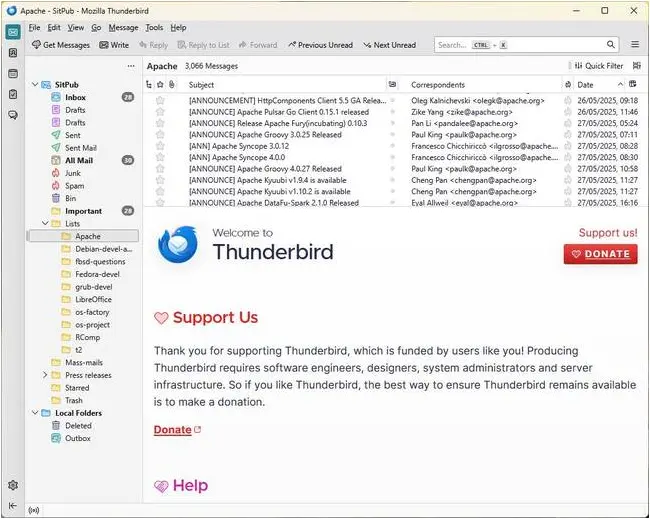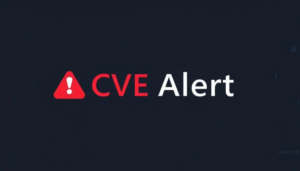Thunderbird Is Go: 139 Follows Closely On Firefox’s Heels
Mozilla subsidiary MZLA has released the latest version of its messaging client, with some handy extras.
Thunderbird 139 is out, following the new monthly release cycle that we covered a month ago. Thunderbird now has short-term releases that track the upstream Firefox releases, but if you don’t want your email client to change that often, you can still choose the extended support release (ESR) version. On the download page click on Release Channel and choose Thunderbird Extended Support Release.

Thunderbird 139, in its classic table view – which is just a couple of clicks away – click to enlarge
With the looming end of Windows 10, we know that more people are looking at getting away from Microsoft tooling in general, not just Microsoft OSes. We’ve already described how to switch to the LTSC branch of Windows 10, but some readers expressed concern that this extended support coverage wouldn’t include Microsoft Office 365 as well. Frankly, to us that sounds like a good reason to dump Office altogether.
Both Windows and macOS have their own email clients, of course, although in the opinion of the Reg FOSS desk, Thunderbird is preferable to either of them. However, Thunderbird is the default messaging client in many Linux distributions. The change to the release schedule was only announced in March so this is too recent for most fixed-release-cycle distros. We checked a handy Ubuntu 24.04 machine, and for now, it remains on the ESR – at the time of writing, the latest version in the Snap store is in the beta channel, which has 139 beta 4-2.
The new features in this version are small, but good to have all the same. There are some tweaks for enterprise policy management, although we don’t know of any enterprise Windows users who’ve standardized on Thunderbird – even if they should.
When the app shows a notification for a new message, you can now mark it as read, or delete it, right from the notification. You can manually sort the entries in the folder pane, and adjust the number of rows of preview text shown in each card in the card view.
Judging from the comments we’ve seen in multiple forums, the new Card View seems to cause many people consternation. It was introduced as part of the Thunderbird 115 “Supernova” UI refresh, and MZLA’s own page about the change has a clear before-and-after illustration showing the difference.
By way of a disclaimer: personally, this vulture doesn’t use card view at all. We prefer the old view, now called “table view”, and we turned off card view as soon as it became an option. If the card view has put you off Thunderbird, it’s very easy to change: there’s a button in the user interface at the end of the header row of the thread list. It’s immediately to the right of the Quick Filter button, or alternatively, in the app’s Settings screen, it’s the top item in the Appearance section. Mozilla has a page about changing views. Some users are reporting a bug when upgrading, saying that version 139 reverts to card view even when they had table view in the old version, but it’s very quick to change back.
Other aspects of the user interface can be customized as well. A few years ago, we described how to use a custom stylesheet to hide Firefox’s tabs bar if you were using a vertical-tabs extension. The same method works to move Thunderbird’s menu bar to the top of the window, where it belongs. (Ironically enough, we recently removed that tweak from Firefox since version 136 integrated vertical tabs.)
In the same way, you can do much more serious customization with user stylesheets. This Reddit post by Kosmour shows how to change Thunderbird to look more like Outlook 365, and this blog post walks you through the steps in more detail. This may not be what this vulture wants Thunderbird to look like, but these sorts of steps could assist less-techie users if you’re migrating away from Windows 10 and Microsoft tooling. ®
Bootnote
Incidentally, we keep referring to Thunderbird as a messaging client and not an email client for a good reason: it does a lot more than just email. It’s also a chat client – it’s our default client for Matrix. It’s also a capable Usenet News client, too. And of course it can also handle network calendars and address books, including Google Apps and Microsoft 365 ones.
A considerable amount of time and effort goes into maintaining this website, creating backend automation and creating new features and content for you to make actionable intelligence decisions. Everyone that supports the site helps enable new functionality.
If you like the site, please support us on “Patreon” or “Buy Me A Coffee” using the buttons below
To keep up to date follow us on the below channels.


